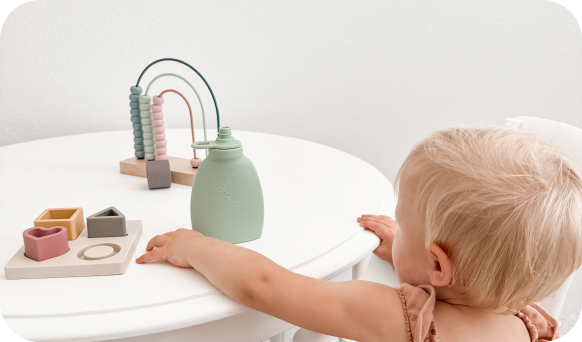How We Turned Snack Time Into A Gut-Healthy Routine

We used to hit the dreaded snack wall every single day. It is that familiar moment when your toddler throws a tantrum and you are too tired to have a talk with him, too exhausted to talk over the scene and you reach for that bag of crackers or those puffs because it is the simplest thing to do.
But here’s the twist: we found a way to make snack time work for all of us. Now, instead of quick processed snacks, we have: smoothies or yogurt in pouches for toddlers or whole-food snacks and a lot less stress. And the best part? Theo can digest more smoothly, his energy is more consistent, and I feel I am finally doing snack time correctly.
This guide discusses the changes we made, why they help and how you can create your own gut-healthy snack routine without making things complicated. Read on to learn more.
The Problem With Processed Snacks
Let’s be honest, processed snacks are tempting. They’re fast, they’re shelf-stable, and they make toddlers happy for at least three minutes. But most of them come with hidden sugars, artificial flavors, and very little real nutrition. Here’s what we noticed when processed snacks ruled our afternoons:

- Theo’s mood swings got worse.
- He was hungry again just 30 minutes later.
- Digestion issues started showing up like tummy aches and occasional constipation.
It was a cycle we didn’t want to repeat. So, we decided to figure out how to avoid processed foods without feeling like snack time had to become a full-time job.
Learn more in: Why Smoothies Are The Best Way To Reduce Ultra-Processed Foods
Our Simple Gut-Healthy Swap
Instead of packaged snacks, we use snack cups for real food. They’re easy to pack and easy to hold, and they keep portions just right. Here’s what I rotate through each week:
- Grass-fed cheese cubes
- Cut-up grass-fed beef sticks (Chomps-style)
- Hard-boiled egg pieces
- Mini homemade meatballs
- Homemade energy balls
- Oatmeal bites
- Cashews
- All-natural dates or raisins
- Fresh fruit slices (apples, pears, berries)
Why snack cups work so well: the lids keep food fresh, they prevent spills in the car or stroller and the small size helps kids see the whole snack at once, so they actually finish it. With this setup, snack time became a quick grab-and-go moment, but without the processed junk.
Why It Works for Toddlers
Toddlers need snacks that are easy to eat, full of nutrients, and gentle on their little tummies. Pouches for toddlers are perfect because they’re mess-free, portion-controlled, and easy to take anywhere.
But the real win came from what we put inside:
- Smoothies made with fruit, greens, and a little avocado for healthy fats.
- Greek yogurt with blended berries for protein and probiotics.
- Oatmeal purees for fiber and energy
When Theo eats these snacks, his energy lasts longer, his digestion stays regular, and his mood is calmer.
Building Your Gut-Healthy Snack Routine
Switching to a gut-friendly snack routine doesn’t have to be complicated. Here’s how we made the transition:

1. Start With Familiar Flavors:
Kids can be suspicious of new foods. Begin by mixing their favorites with a new ingredient. For example, blend banana with spinach in a smoothie.
2. Use Reusable Pouches:
They make snacks portable and cut down on waste. Plus, you control exactly what goes inside.
3. Prep Ahead:
Make a batch of snacks on Sunday. Store them in the fridge in small containers or pouches so they’re ready when you need them.
4. Keep It Balanced:
Pair true carbs with protein and healthy fats. This keeps kids full and stabilizes blood sugar.
Nutritious Snack Recipes We Love
These nutritious snack recipes fit into snack cups and keep our gut-healthy routine easy.
- Grass-Fed Cheese Cubes: Cut high-quality grass-fed cheese into bite-sized cubes. Store in snack cups for a quick, protein-rich option.
- Cut-Up Chomps: Slice Chomps meat sticks into small, snackable pieces. Perfect for grab-and-go moments.
- Hard-Boiled Egg Pieces: Boil eggs, peel, and cut into halves or quarters. Sprinkle with a pinch of sea salt and store in snack cups.
- Mini Homemade Meatballs: Bake small meatballs using grass-fed beef. Cool, then place in snack cups for a filling protein snack.
- Homemade Energy Balls: Roll a mixture of oats, nut butter, honey, and seeds into small balls. Store chilled in snack cups.
- Oatmeal Bites: Bake bite-sized oatmeal squares or rounds. Pack in snack cups for a wholesome treat.
- Cashews and All-Natural Dates/Raisins: Combine for a balanced sweet-and-salty snack mix.
- Fruit Slices: Slice apples, pears, or other firm fruits. Store with a lemon-water spritz to keep fresh in snack cups.
Read more in: Smart Snacking: Healthy Hard Snacks for Toddlers
Making It Fun for Kids
One of the best things we did was involve Theo in snack prep. He loves helping fill the pouches or putting fruit slices in his snack cup. It makes him more excited to eat what we’ve made and less likely to ask for chips or candy. You can make it fun by:

- Letting kids choose between two snack options.
- Using colorful cups.
- Turning snack time into a mini picnic.
Our Secret Weapon: The Snack Time Combo Pack
The Snack Time Combo Pack has been a total game-changer for us. The set includes both reusable pouches for purees, yogurt, or smoothies and snack cups for harder snacks like cheese cubes, mini meatballs, oatmeal bites, and roasted veggies. It even comes with a matching brush and funnel for easy prep and clean up.
Why we love it:
- Works for both soft and solid snacks.
- Easy to wash and reuse, no waste.
- Saves time because everything is portion-ready.
How to Avoid Processed Foods Without Stress
Changing snack habits doesn’t have to be overwhelming. Here’s what helped us:
- Plan ahead: Keep fresh snacks prepped and visible in the fridge.
- Read labels: If it has a long ingredient list you can’t pronounce, skip it.
- Swap gradually: Replace one processed snack a day with a homemade one.
Over time, you’ll notice your child asking for whole foods more often than packaged ones.
The Results We’ve Seen
Since making the switch, the changes have been clear:
- Theo’s digestion improved; fewer tummy troubles.
- His energy is steady, not up and down.
- Snack time is calmer for everyone.
And for me? I feel confident knowing I’m feeding him snacks that truly help his growth and health.
Conclusion:
Snack time doesn’t have to be a battle between convenience and health. With a few swaps, a little prep, and the right tools like reusable pouches, you can create a routine that’s good for your toddler’s gut and easy for you. So, are you ready to try it? Your toddler’s digestion, mood, and energy will thank you and you might just find snack time becoming your favorite part of the day. Make snack time simple. Try the Snack Time Combo Pack today.
References:
1. Healthline. (2021, September 14). Healthy Food vs. Highly Processed Food: What to Know. Retrieved from
https://www.healthline.com/nutrition/junk-food-vs-healthy-food
2. Medical News Today. (n.d.). Avocado: Nutrition, Benefits, and More. Retrieved from
https://www.medicalnewstoday.com/articles/avocados
3. To Taste. (2022, June 7). Frozen Berry Smoothie with Greek Yogurt. Retrieved from
https://totaste.com/recipes/frozen-berry-smoothie-with-greek-yogurt
4. Healthline. (n.d.). Oats 101: Nutrition Facts and Health Benefits. Retrieved from
https://www.healthline.com/nutrition/foods/oats
